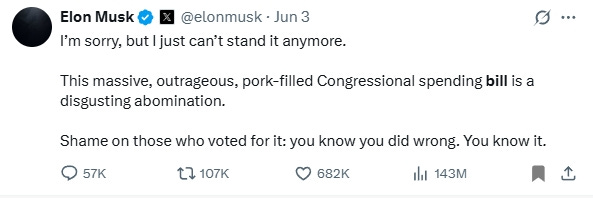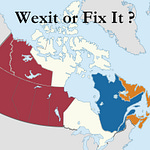The defining legacy of Trump’s first term is that, within the first couple of weeks after it ended, President Biden’s executive pen erased virtually every mark Trump had left on America’s system. The US rejoined the Paris Climate agreement. Construction of the border wall was stopped (and construction materials were auctioned off for pennies on the dollar). The doors were once again thrown wide open to even more uncontrolled illegal migration. And existing oil and gas development permits were rescinded or suspended.
Even the Keystone XL Pipeline permit, which was mandated into existence by Trump in 2017 as an executive order during the first days of his presidency to put a stop to a decade of ideological bureaucratic obstructionism, was revoked by Biden in the first days of his presidency in 2021, also by executive order. The company building the pipeline (TC Energy) launched a $15 billion lawsuit against the U.S. government to try to recover its investments (construction was already well underway!), but a trade tribunal tossed out their claim in 2024, cynically ruling that since the permit had been issued under NAFTA rules but NAFTA no longer existed since it had been replaced by the US-Mexico-Canada trade agreement, the company was not entitled to compensation. The province of Alberta also has a $1.3 billion lawsuit running against the U.S. government to try to recover its share of investments into the Keystone XL project — that lawsuit is still ongoing.
There’s no shortage of examples of how Trump 1.0’s legacy was erased as soon as he left office. Not only did Trump not leave a mark but, with the stroke of the executive pen, contracts, permits, negotiations, and investments conducted in good faith under his watch subsequently became financial and legal liabilities for companies and even for foreign governments as soon as a different set of hands gained authority over the executive pen.
That’s the trouble with ‘rule by executive order’ — it’s arbitrary, temporary, unaccountable, dictatorial, and frequently vengeful. And the ideologically-captured courts are happy to play along, thus legitimizing this arbitrary power into law. What’s lawful versus what’s right increasingly no longer overlap.
When the Founding Fathers drafted their Constitution, presidential authority to issue executive orders wasn’t explicitly defined, and their use was originally very limited, mostly for administrative or minor procedural matters – in those days, the young federal government had a limited scope, and the separation of powers was strictly interpreted. Law-making at the federal level was the responsibility of Congress — full stop. And most of the laws that directly affected citizens’ lives were made at the state level (by state legislatures) — again, full stop. Presidential authority was little more than a thin and rarely-felt overlay to tie that republic together, with the president’s primary responsibilities limited to defense and international diplomacy, to ensure that laws were properly enforced, and to create a check on Congress’s legislative power.
Not anymore.
One precedent after another has gradually expanded the power of the executive branch to the point where, today, an executive order increasingly resembles a royal decree that is routinely used to bypass Congress, even as Congress willfully abdicates is lawmaking responsibilities to both the judicial and executive branches.
Don’t let the legalese deceive you — “rule of law” has given way to “rule by law” as judicial decisions, bureaucratic decrees, and executive governance are increasingly reinterpreted and enforced not by principle but rather primarily based on the priorities of whichever party is in control of that institution. Even the idea of an impartial judiciary has long-since given way to a politicized judiciary that’s frequently engaged in social-engineering. Americans may have given King George III a proverbial bloody nose during their Revolutionary War, but today King George III must be laughing in his grave as America (regardless of which party is in charge) evolves to become exactly what they fought to liberate themselves from in 1776.
If you want to know where this evolving system leads, you only have to look north to Canada to the arbitrary and almost absolute authority that is exercised by our Prime Minister, Privy Council, and the myriad of unaccountable bureaucracies that rule over us. Canada never managed to cast off King George III’s shadow — it is baked right into our constitution even if the prime minister has replaced the king as the de-facto governing head of our constitutional monarchy.
As we’ve seen time and time again, our “constitution” means whatever our prime minister and our bureaucracies want it to mean on any given day as our ‘constitutional monarchy’ evolves to become a ‘bureaucratic tyranny’ in all but name. Our recently elected prime minister, Mark Carney, has even rolled out a new plan to build “one Canadian economy, not thirteen” — it’s the ultimate symbol of the collapse of provincial sovereignty and local decision-making. The relentless centralization and expansion of arbitrary federal powers on either side of our border continues unabated — Canada leads the way, but the US is not far behind.
Trump didn’t create this arbitrary and abusive system in America. However, he also did nothing to dismantle that arbitrary centralized authority or to reverse America’s evolution away from a decentralized republic towards quasi-imperial rule. Instead, like every president before him, he used that power to rule America according to his vision of what is best for the country, thus continuing the well-established tradition of stretching the power of the executive pen just a little bit further with each new administration to bypass the tedious and time-consuming process of lawmaking via Congress, just as Obama, Bush, Clinton, Bush Sr., Reagan, and so many others did before him.
And Biden continued that centuries-long tradition when he followed Trump into office… and the precedents he set through his use of the executive pen only expanded that arbitrary power still further.
The main political struggle today is no longer about the separation of powers that once gave the republic its vitality, or about imposing limits on government authority, or about restoring state sovereignty — it’s all about which party gets to be in charge of that vast centralized authority and what new schemes can be dreamt up to reshape America through government meddling. Each side predictably cries foul when their opponents use that power while cheerfully unleashing that same power to the maximum extent as soon as they get their fingers on the throne — neither decentralization nor the dismantling of excess government authority is on the menu.
On so many other levels, Trump 1.0 was equally disappointing not because his administration represented a break with the past (as Democrats and mainstream media would have us believe), but because, other than the mean tweets, it was a continuation of many of the structural issues of the past. Sure, Trump 1.0 changed the curtains and the music, but beneath the fluff all the core elements that are undermining the decentralized, liberty-focused Idea of America remained in place.
Out-of-control spending and out-of-control debt continued to grow unchecked under Trump 1.0 (even before Covid) despite his fierce criticisms of both of those things before he assumed office. And his lockdowns, mask mandates, and Operation Warp Speed were textbook cases of authoritarian diktats — the perfect illustrations of the philosophical shift that has taken place in America over the past two centuries as government evolved from ‘protector of rights’ to ‘meddling shepherd in charge of engineering outcomes’. Through these actions, Trump proved once again why central planning always ends in a disaster regardless of whether the intentions are good or bad. Biden’s Covid policies were even more authoritarian and heavy-handed than Trump’s as his vision of government intervention went still further but, in reality, both presidents are merely separated by degrees, not by philosophical principle.
Trump 1.0 also supported (and even expanded) the military build up in the Ukraine and the tone-deaf stance taken by NATO as it threatened to expand onto Russia’s doorstep, thus giving the lie to his claim that if he had won the 2020 election, the Ukraine War would never have happened (on the contrary, his policies towards the Ukraine contributed in equal measure towards provoking Russia’s Special Military Operation). Perhaps the start date of the war would have been different, but that’s not the same as defusing tensions — the nuanced understanding of what it takes to co-exist with other Great Powers was missing.
And, despite criticizing Obama’s use of drone strikes abroad (a.k.a. targeted assassinations without due judicial process) as reckless, strategically flawed, lacking in transparency, lacking in judicial process, prone to civilian casualties, and ripe with moral problems, after Trump assumed office he nevertheless increased the use of those same drone strikes and expanded America’s counterterrorism footprint in other countries. Even his use of tariffs to reshape the economy to his liking was merely an expansion of Obama’s use of tariffs, and indeed Biden kept most of Trump 1.0’s protectionist “friend-shoring” tariffs in place when he assumed office. Trump 1.0 wasn’t the course-correction that many of his supporters had hoped for when they voted him into office with a mandate to drain the Swamp.
Trump 1.0 also never managed to get American troops out of Afghanistan despite his criticism of the long war as America’s mission morphed from destroying al-Qaeda into a failed attempt to impose Western-style centralized liberal democracy. He even briefly hired neo-con John Bolton (!) as his National Security Advisor and brought in Mike Pompeo as his CIA director — in both cases signalling an overt continuity of the Washington Swamp he had allegedly come to drain. Nor did he pardon either Julian Assange or Edward Snowden, nor did he dismantle (or meaningfully reform) the overbearing national security apparatus that they had exposed.
The system Trump 1.0 left behind was arguably just as bloated, unreformed, and out-of-control as when he assumed office, with the Deep State still aggressively managing American and world affairs behind the scenes. Despite all the noise and the smoke, the nuts and bolts of the system remained unchanged. After Trump 1.0 left office, his imprint on the system faded almost immediately – erased by a few executive orders. Colonel Douglas McGregor recently said something to the effect that ‘Trump 1.0 set out to master the Washington Swamp, but in the end the Washington Swamp mastered Trump.’
But perhaps Trump 2.0 would be different…
The experiences of wrestling against America’s entrenched political establishment and tussling with the embedded Deep State during his first term, followed by the predatory lawfare unleashed against him by a vengeful regime throughout the entire four years after the 2020 election, seemed to produce a kind of “awakening” to make him aware of the scale and scope of the systemic rot that had infected the system and the degree to which the agencies had fed him bad information in his first term. If the political forces, agencies, and bureaucrats could so easily circumnavigate and trample even an elected president and multi-billionaire, what recourse does the average citizen have? It’s not just that the laws are bad, it’s that the very structure of the system is rotten, compromised to its very core, and ripe for abuse. If you want to drain the Swamp, your reforms have to be a lot more ambitious than merely rearranging the deck chairs on the Titanic to suit your priorities.
Early signs suggested that Trump 2.0 would indeed be different, not just based on his rhetoric but by the fact that he seemed to surround himself with a very different cadre of people (Kennedy, Tulsi, Vivek, Elon, etc), all of them more libertarian minded (to varying degrees) and all of which were vocal critics of the Swamp. Perhaps Trump 2.0 would finally go where Trump 1.0 had dared not tread?
Alas, it was not to be.
We’re almost 5 months in and it’s becoming quite clear that even if you get some policies you like (and yes, there have been quite a few of those), overall Trump 2.0 isn’t shaping up to be any more of a structural reformer than Trump 1.0 was. Trump’s vision for America is no stand-in for Ron Paul or the Founding Fathers — not even close. As he himself has indicated through his admiration of President William McKinley, Trump is styling himself in the tradition of the early Progressive Era presidents (1890s–1920s), which are traditionally listed as William McKinley, Theodore Roosevelt, William Howard Taft, and Woodrow Wilson — all of which embraced the vision of using government as a sledgehammer to impose their will upon the nation. Woodrow Wilson perhaps best summed up the Progressive philosophy in his 1887 book, The Study of Administration:
“no one can doubt that in some way it [the federal government] must make itself master of masterful corporations. ... The idea of the state and the consequent ideal of its duty are undergoing noteworthy change; ... Seeing every day new things which the state ought to do, the next thing is to see clearly how it ought to do them.”
Ever since, presidents have not lacked for seeing new things that the state ought to do.
Sure, some (but only some) of Trump 2.0’s policies are very different from Biden’s — but has centralized power been dismantled? Even on issues where there have been desirable changes in policy, what’s to prevent things from reverting the moment he leaves office as the executive pen rears its ugly head to, once again, sweep it all away? What has Trump done, structurally, that cannot be undone by the next president in the first days of assuming office? Without dismantling the federal government’s authority to insert itself into everything, life inside America will continue to revolve around presidential whims.
And despite some positive changes on some levels, on so many other levels there hasn’t been a change of direction at all. As I will demonstrate in the second half of this essay below, the lack of a coherent vision of the future is on plain display as Trump is, once again, being mastered by the Washington Swamp or (equally damaging) as Trump’s lack of clear vision, lack of clear follow-through, lack of political support even within his own party, and his poor communication skills leaves America (and the world) floundering on the same path as before.
Trump 2.0 MUST succeed, otherwise America and the Western world face a very bleak future as Western Civilization slides ever deeper into centrally planned global socialism. “Winning” isn’t about getting the policies you want. “Winning” (a.k.a. draining the Swamp and keeping it drained even after you leave office) requires dismantling centralized power to make sure that no-one, good or bad, ever has this much centralized control over the country ever again.
As President Gerald Ford once said (though he was not the first to say it), “A government big enough to give you everything you want, is a government big enough to take away everything that you have.” Even if you get the policies you want today, it’s not a mystery what happens to America if the Democrats ever get their hands back on those immense levers of power. And it may be irrelevant whether they do or not if Republican hands are equally eager use that power to impose their alternate Progressive vision of America. Either way, the central planner’s sledgehammer is controlled by whoever has the president’s ear and you’re only ever one election away from losing everything based on the stroke of a pen.
And so, over the coming paragraphs, I want to take a bird’s eye view of Trump 2.0 to understand what is evolving out of his 2nd term – the growing risks, the unaddressed problems, the dangerous precedents that are being set, the minefields that are building up everywhere, the structural reforms that simply aren’t being undertaken, and the philosophical void that unites it all.
As it stands today, the legacy of Trump’s 2nd term risks being as fleeting as his first. America’s evolution towards a quasi-imperial system remains unchecked and all the dominoes continue to be put in place for Western Civilization as a whole to devolve into a Chinese-style global authoritarian surveillance state.
The seeds sown by Trump 2.0 will be bitter indeed if they are allowed to bear fruit. “Winning” requires something more…
Debt & Deficits
The recent dust-up between Elon Musk and President Trump is perhaps a good place to start as Elon lost his patience with Trump’s Big Beautiful Bill, which increases the debt ceiling by another 5 trillion dollars even as the deficit increases to $2.5 trillion. Spending cuts are backloaded to 2029, which would stick the next president with the fiscal drag. This isn’t what Elon signed up for.
Ron Paul summarized it best:
“Decade after decade, the Republicans disappoint. They can control all levers of government and they still disappoint.
The election last November was supposed to put an end to that.
Republicans (with massive public support at their backs) were finally going to lessen the major burdens that Americans are forced to shoulder (spending, deficits, and debt).
But then came the Big Beautiful Bill, and once again, Republicans disappoint.
All three of the burdens will continue to rise.
Elon Musk, who was very instrumental in the election, finally had enough. He joined Thomas Massie & Rand Paul in saying we need a SLIM Beautiful Bill.”
Trump’s current direction does not put America back onto a sustainable fiscal path with a small federal government footprint. Quite the opposite — the longer that these unsolved financial risks continue to accumulate, the more certain it becomes that America will either face a massive future bond crisis or engage in massive dollar devaluation and inflationary money printing to inflate away its financial liabilities (which would also ultimately lead to a bond crisis). The longer you delay this, the bigger that the reckoning will be when it finally comes. As I explained in a previous article, the bond market is already getting nervous — decades of fiscal irresponsibility and accumulating debt are beginning to catch up to America.
Furthermore, an authoritarian state needs money. You cannot dismantle a bloated authoritarian state if you don’t deprive it of the cash to fund its activities. You can’t drain the Swamp if you don’t take away the food-source that the Swamp feeds on. Trump’s decision to continue to fund Big Government has grave implications for America’s future — despite all the noise, in the end there’s no philosophical shift in the size, scope, or reach of the federal government, merely a continuation of the century-long war over who gets to control the levers of this massive centrally-planned apparatus.
In other words, business as usual.
Instead of cutting government down to size and reviving the free market in America, Trump is growing the federal footprint by taking out an additional mortgage. If now is not the time to cut the federal monstrosity back down to size, then when?
DOGE
There are two issues with DOGE…
After initially advertising that more than $2 trillion in waste could be cut from the government, that number has been dropping ever since. As I write this, GOP leaders finally have a bill on the floor of the House of Representatives to codify a package of cuts worth… wait for it… $9.4 billion. That’s 0.47% of the initial advertised cuts. Not 47%. Not 4.7%. Only 0.47% — less than half of 1 percent!?!. Perhaps there will be more bills forthcoming… but seriously?!?
Clearly, a lot of people have become dependent on “waste” and Congress doesn’t want to risk upsetting any of them. That waste may do nothing for America and makes taxpayers poorer, but cutting it is a major political risk because every voter, lobbyist, and regime supporter who has grown financially dependent on that waste is not going to take kindly to being cut off from the trough. Best not to shake the tree too hard.
But there’s an even bigger philosophical question at stake.
Do you even want an efficient government when that government is trending towards ever greater centralized control? This comes down to the philosophical question I alluded to when I brought up the Progressive Era presidents earlier in this article — do you want a big efficient centralized government that organizes, orchestrates, and manages everything, or do you want a small, lean, minimalist federal government, while everything else happens at the state and local levels and in the private free market, as the Founding Fathers intended.
In his book, Skin in the Game, author Nassim Nicholas Taleb framed this philosophical conundrum as follows:
“I am, at the Fed level, a libertarian;
at the state level, a republican;
at the local level, a democrat;
and at the family and friends’ level, a socialist.
If that saying doesn’t convince you of the fatuousness of left vs. right labels, nothing will.”
The best way to cut “waste” is not to make bureaucracies more efficient. The best way to cut waste is to eliminate the bureaucracies altogether and push the authority to regulate things back down to the state level where the Founding Fathers initially placed it. With 50+ states all doing their own regulation, competition would emerge, and a price would be paid by states that over-regulate and overtax their citizens. But as long as America continues to evolve to become a centralized jackboot, the last thing you need is for that jackboot to become more efficient at controlling you because eventually the machinery of government will be in the hands of someone who views your way of life as a target.
DOGE should have been about cutting agencies altogether, not trimming spending and waste that can grow back as soon as the current mood subsides.
Even the mythical Greek hero, Hercules, in his fight against the Hydra, had to learn that in order to defeat the multiplying heads of the multi-headed serpent, it wasn’t enough to cut off the heads, it also required cauterizing the stumps with fire after each beheading to prevent them from growing back.

Bureaucracy
This brings us to the next point. Elon Musk pointed out that the U.S. has 428 federal agencies, and that they are growing at a rate of two per year as the government just keeps finding “new things that the state ought to do”.
He suggested that the number should be cut to 99 agencies, though in my opinion that’s still far too many if you want to resurrect the philosophical vitality of a decentralized republic. Most of this stuff should be happening at the state level, not at a single federal level.
Imagine if Texas, South Dakota, and California all kept their own climate records instead of it all being concentrated in the hands of the single federal National Oceanic and Atmospheric Administration (NOAA) – if one of fifty state-level agencies starts “adjusting” their numbers to fit a preferred narrative, but others don’t, transparency begins to emerge, and cheaters are easier to expose. But as it stands now, whistleblowers are simply ignored as the rot soaks ever deeper into the fabric of these all-encompassing institutions.
But here’s what is happening instead:
Before I dive into the remainder of this essay — into the details of where Trump has fallen short both on the domestic front and on the world stage, from the Ukraine to Israel and beyond, and the dangerous world that is emerging as a result of these shortcomings — I want to thank all my paid subscribers for your support. It means the world to me!
If you are not already a paid subscriber, I’d like to ask for your support in the form of a paid subscription to my Substack. These kinds of essays require a colossal amount of time, effort, and research to produce. My freedom to explore ideas and think out-of-the-box comes from the fact that I am 100% reader-supported by people like you.
And if you’re not quite ready to sign up for a paid subscription, perhaps you’d consider leaving me a tip in the Tip Jar on my website to help support my writing.














